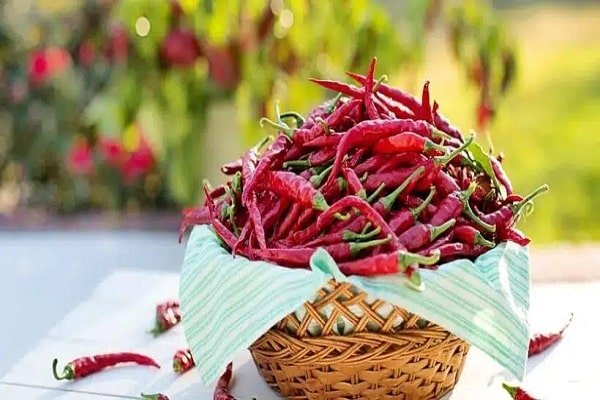India’s Position in the Global Dry Chilli Export Market
India’s Position in the Global Dry Chilli Export Market: India – The Spicy King of Dry Chilli Exports! It is famous for its hot and aromatic dried chillies, considered to be especially popular among lovers of spices. India, the largest Spice Exporter in India, also has a diverse production of chillies, including the Guntur chillies of Andhra Pradesh and Byadgi chillies of Karnataka. Due to favorable climate, availability of a skilled workforce, and a strong history of agriculture, India has emerged as the largest exporter of dry chillies. But it’s not just quantity, India has become a top producer by maintaining quality and safety standards as well as using eco-friendly farming techniques.

Indian dry chillies are now exported to china, the United States of America, Thailand and even the Middle East due to the increasing global demand. New techniques for the processing of spices and adhering to international quality standards are making India’s spices stronger in the global market. In this blog, we will discuss India’s Position in the Global Dry Chilli Export Market, its success, major export markets, and prospects.
India’s Dry Chilli Production: A Global Leader
India is one of the largest Dry Chilli Exporters in India and has major hectares of growth in the states. Here are the common sources by state:
| State | Major Chilli Variety | Production Share (%) |
| Andhra Pradesh | Guntur, Teja | 45% |
| Karnataka | Byadgi, Dabbi | 15% |
| Madhya Pradesh | Jwala, Teja | 12% |
| Maharashtra | Sankeshwari, Super-10 | 10% |
| Tamil Nadu | Mundu, Gundu | 8% |
| Gujarat | Jwala, Reshampatti | 6% |
| Others | Various | 4% |
- Guntur chillies are predominantly exported as they are highly pungent and have a deep red colour, unlike other varieties.
- Byadgi chillies are used by the food processing industries since they are bright in colour and have a very mild heat intensity.
India’s Dry Chilli Export Performance
India’s Position in the Global Dry Chilli Export Market is evident as it continues to dominate international trade. Today, India exports chilies to more than 100 countries, and it has been an important component of the agricultural exports of the country. Below are the latest statistics:
| Year | Export Volume (Metric Tons) | Export Value (Million USD) |
| 2020-21 | 5,00,250 | 1,014 |
| 2021-22 | 5,23,000 | 1,083 |
| 2022-23 | 5,50,000 | 1,200 |
| 2023-24 | 5,75,000 | 1,280 |
- The export quantity is increasing constantly, which points towards the increasing demand for Indian chillies in the international market.
- The value increased to $1 billion, which reflects the rising demand for high-quality Indian chillies as a specialty product.
Top Importing Countries for Indian Dry Chillies
| Country | Import Share (%) |
| China | 38% |
| Thailand | 14% |
| USA | 13% |
| Malaysia | 9% |
| Bangladesh | 8% |
| Sri Lanka | 6% |
| Others | 12% |
- Food processing and spices are some of the primary uses where Chinese import the largest product, which is the dry chillies from India.
- The USA and Thailand are the two leading producers of high quality pesticide free chillies.
Types of Chilli Exports from India
The following are some of the main varieties of Red Chilli Exports from India:
| Chilli Variety | Origin State | Color | Primary Export Markets | Key Characteristics |
| Guntur Sannam | Andhra Pradesh | Bright Red | USA, Vietnam, China | Moderate heat, widely used for cooking and spice blends. |
| Byadgi | Karnataka | Deep Red | USA, Europe, Southeast Asia | Low heat, rich red color, used in food coloring and cosmetics. |
| Teja (S17) | Andhra Pradesh | Bright Red | China, Bangladesh, Thailand | Extremely spicy, sharp flavor, popular in spicy sauces. |
| Kashmiri | Jammu & Kashmir | Dark Red | USA, UK, Middle East | Low heat, deep red color, used in curries and garnishing. |
| Dhani | Manipur, Mizoram | Deep Red | Southeast Asia | Small-sized, very spicy, widely used in Asian cuisines. |
| Mundu | Tamil Nadu | Light Red | Sri Lanka, Singapore | Round-shaped, medium heat, used in South Indian dishes. |
| Bhut Jolokia | Assam, Nagaland | Red-Orange | USA, UK, Germany | Among the hottest chillies in the world, used in hot sauces and defense applications. |
Why Indian Dry Chillies Dominate the Global Market?
Indian dry chillies dominate the global market due to their wide variety, high quality, favorable climate, advanced processing, competitive pricing, and strong supply chain.
Wide Variety and High Quality
- India alone has more than 15 types of dry chillies, and they differ according to the international taste.
- India’s Position in the Global Dry Chilli Export Market is reinforced by the wide availability of chillies with varying pungency, color, and oil content, making them suitable for different industries.
Favorable Climate and Large Cultivation Area
- India enjoys an optimal climate for the growth of chillies and has ample irrigation facilities.
- Chilli production increases by having over 1.5 million hectares of land under cultivation.
Advanced Processing and Quality Control
- India has used modern methods in drying, cleaning and grading to ensure the food safety that complies with world standards.
- The major exporting firms abide by standards such as HACCP, ISO and FSSAI in their effort to maintain quality.
Competitive Pricing and Strong Supply Chain
- Indian chillies are cheaper but have high quality, which makes it possible for them to easily compete in the export market.
- The southern region of the country has developed export centers in Guntur, Warangal, and Hubli that facilitate efficient exportation.
Challenges Faced by India in the Dry Chilli Export Market
However, certain issues and challenges have made it slightly difficult for India to sustain its position globally.
- Pesticide Residue Issues: One of the problems with pesticide residues, some of the shipments are getting reject due to high pesticide residue levels, there is a need to improve the management of farms.
- Yield instability: Sometimes, farming gets affect by weather conditions or pests that reduce crop yield, which affects the price.
- Other Countries Competitors: Competitors from China, Vietnam, and Mexico are seen as some of the major competitors in the export of chili.
- Export Regulation Compliance: Different countries have their food safety laws hence it becomes a challenge to constantly address standard set by the EU, USA and Japan.
Conclusion
Without a doubt, India’s Position in the Global Dry Chilli Export Market is not matchable, with high-quality chillies reaching worldwide markets. India has always been a leader in spice exports, and even today, with a good production base in agriculture, different types of spices and enhanced processing methods.
Therefore, to retain and increase its market share, there is a need to address the issues of quality control, pesticide-free agriculture, and value-added spice products. By addressing these key areas, India can further strengthen its Position in the Global Dry Chilli Export Market and continue to spice up global cuisines for years to come.
